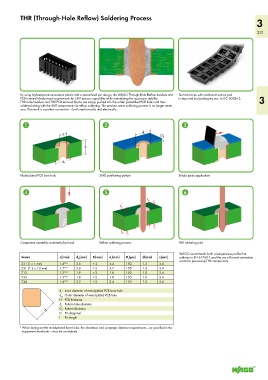Page 233 - Wago_PCB_TerminalBlocksConnectors_Volume2_2015_US
P. 233
THR (Through-Hole Reflow) Soldering Process
3
231
By using high-temperature-resistant plastic and a streamlined pin design, the WAGO Through-Hole Reflow headers and Terminal strips with additional suction pad
PCB terminal blocks meet requirements for SMT process capability while maintaining the necessary stability. in tape-and-reel packaging acc. to IEC 60286-3, 3
THR male headers and THR PCB terminal blocks are simply pushed into the solder paste-filled PCB holes and then
soldered along with the SMT components via reflow soldering. The previous wave soldering process is no longer neces-
sary. The result is a perfect connection — both mechanically and electrically.
1 2 3
______>
_> ______> d s
d i D s <__
_>
______> <
H ______>
______>
d A
_______>
Metal-plated PCB bore hole SMD positioning pattern Solder paste application
4 5 6
Component assembly, automatic/by hand Reflow soldering process THR soldering joint
WAGO recommends both a temperature profile that
Series d(mm) d (mm) H(mm) d (mm) D (μm) d(mm) L(mm) adheres to EN 61760-1 and the use of forced convection
s
s
i
A
ovens for processing THR components.
231 (1 x 1 mm) 1.4 +0.1 2.5 < 2 2.4 150 1.2 2.4
231 (1.2 x 1.2 mm) 1.7 +0.1 2.8 < 2 2.7 150 1.5 2.4
713 1.2 +0.1 1.9 < 2 1.8 150 1.0 2.4
733 1.2 +0.1 1.9 < 2 1.8 150 1.0 2.4
734 1.4 +0.1 2.5 < 2 2.4 150 1.2 2.4
d: Inner diameter of metal-plated PCB bore hole
i
d : Outer diameter of metal-plated PCB hole
A
H PCB thickness
<____________ d___________> D : Pattern thickness
d : Pattern hole diameter
s
s
D Pin diagonal
L Pin length
* When laying out the metal-plated bore holes, the clearance and creepage distance requirements — as specified in the
equipment standards — must be considered.

